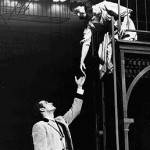When West Side Story premiered in 1957, it marked a turning point in American musical theater — “a provocative and artful blend of music, dance, and plot,” as one critic noted — but getting the work to Broadway had not been easy. “Everyone told us that it was an impossible project,” composer Leonard Bernstein told Rolling Stone, “Besides, who wanted to see a show in which the first-act curtain comes down on two dead bodies lying on the stage?” It was a decade-long series of disappointments and setbacks, but the creative team persevered.
It began in 1947, when director-choreographer Jerome Robbins approached Bernstein and writer Arthur Laurents with an idea for a musical adaptation of Romeo and Juliet set in the Lower East Side of Manhattan, focusing on Catholic Jets and Jewish Emeralds. Laurents wrote a draft of East Side Story, but the team didn’t think it worked, so they dropped the idea.
Years later, Laurents and Bernstein met for drinks in Hollywood, and their conversation turned to Chicano turf wars making headlines. Bernstein suggested they rework East Side Story on that idea, but being more familiar with New York, Laurents suggested Puerto Ricans in Harlem. Robbins was enthusiastic, and Laurents quickly wrote the first draft of West Side Story with Polish-American Jets and Puerto Rican Sharks.
At an opening night party, Laurents met Stephen Sondheim. Bernstein had decided to concentrate on the music, so the team was shopping for a lyricist. With that, the team was set: book by Arthur Laurents, music by Leonard Bernstein, and lyrics by Stephen Sondheim. The show went through numerous changes over the next few years. Characters came and went. Songs were put it and taken out.
Through it all, Laurents explained their guiding principle: “Just as Tony and Maria, our Romeo and Juliet, set themselves apart from the other kids by their love, so we have tried to set them even further apart by their language, their songs, their movement. Wherever possible in the show, we have tried to heighten emotion or to articulate inarticulate adolescence through music, song or dance.”
Then two months before the show was to begin rehearsals, the lead producer dropped out. Luckily, Sondheim was able to get his friend Harold Prince to step in, and the show moved forward. Another setback came when Columbia Records became reluctant to record such a “depressing and difficult score.” In the end, though, they did record the original cast album, which spent 191 weeks on the Billboard charts (peaking at #5) and was inducted into the Grammy Hall of Fame in 1991.
Luckily, the tryout runs in Washington, D.C., and Philadelphia were well received, and the show opened in New York on September 26, 1957, starring Larry Kert (Tony), Carol Lawrence (Maria), and Chita Rivera (Anita). “The American theater took a venturesome forward step,” New York Daily News critic John Chapman wrote. “This is a bold new kind of musical theater.”
The production was nominated for six Tonys (with Robbins winning for choreography) and ran for 732 performances before beginning a national tour in 1959, which returned to Broadway for another 249 performances. The 1961 film adaptation, written by Ernest Lehman and directed by Robert Wise and Robbins, starred Richard Beymer as Tony (dubbed by Jimmy Bryant), Natalie Wood as Maria (dubbed by Marni Nixon), and Rita Moreno as Anita. It was nominated for 11 Oscars and won 10, including Best Picture.
Either the 1957 Broadway cast or 1961 film cast are worth a listen. To learn more about the show’s creation, read Keith Garebian’s The Making of West Side Story (1995). You can also compare the libretto to William Shakespeare’s tragedy in the 1965 Dell edition.
NEXT, listen to the show that was chosen over West Side Story for Best Musical at the Tonys: The Music Man, with book, music, and lyrics by Meredith Willson.
THEN, explore another musical about teenage life in the 1950s — a world away from the Upper West Side of Manhattan: Bye Bye Birdie, with book by Michael Stewart, music by Charles Strouse, and lyrics by Lee Adams.

